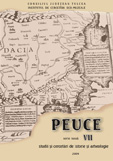A New Bronze Age Axe Discovered in Northern Dobrudja
A New Bronze Age Axe Discovered in Northern Dobrudja
Author(s): Sorin Cristian AilincăiSubject(s): Archaeology
Published by: Institutul de Cercetari Eco-Muzeale Tulcea - Institutul de Istorie si Arheologie
Keywords: copper axe; Bronze Age; isolated find; topor din cupru; epoca bronzului; descoperire întâmplătoare
Summary/Abstract: In 2007, Tulcea History and Archaeology Museum purchased a new shaft-hole axe accidentally found at Malcoci, Nufăru, Tulcea County. The axe is considered to belong to the Pătulele type which is spread in the southern part of Transylvania, Walachia, Moldavia, Oltenia, Banat, Dobrudja and northern and central Bulgaria. The most southern location of this type of axe is Thebes, which serves as an important chronological landmark for dating these axes. On the Romanian territory, the Pătulele type axes are dated to the beginning of the Romanian Middle Bronze Age (2400-2200 B.C., after Al. Vulpe), corresponding to the crystallization of Monteoru, Wietenberg, Tei and Otomani cultures. The presence of several axes of this type in Dobrudja can be attributed to the Jamnaja and Katakombnaja cultures that have been documented by numerous funerary discoveries, especially from Northern Dobrudja. These cultures can also be connected to the presence in Dobrudja of several eastern items like the axes discovered at Mahmudia and the one from Măcin.
Journal: Peuce (Serie Nouă) - Studii şi cercetari de istorie şi arheologie
- Issue Year: VII/2009
- Issue No: 7
- Page Range: 49-56
- Page Count: 8
- Language: English

